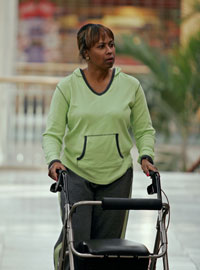By APTA

The benefits of physical activity are well documented and participation in regular physical activity can prevent or reduce the risk of numerous diseases and health conditions. In addition, physical activity has been shown to improve a person’s function and allow him or her to better participate in their chosen life roles. These benefits extend to individuals with functional impairments and movement limitations. In 2008 there were more than 35 million persons in the United States living with a disability in the US. Individuals with mobility challenges often experience difficulties participating in their routine physical activities. They also may experience access problems to typical environments for exercise. Others may be fearful of further injury or have co-morbidities which they perceive as a barrier to activity. These individuals may often require additional education, counseling, and other assistance to overcome barriers and optimally participate in physical activity.
Connecting the Dots: Community Participation
All healthcare professionals need to actively engage patients in conversations about physical activity and its lifelong health benefits. In doing so we need to consider not only their individual needs and capabilities, but also the environment in which they live. But do we provide enough input and advice to our patients to support them in this endeavor? In order to be successful, physical activity needs to be integrated into their lives – where they live, work, learn and play. All healthcare providers should be knowledgeable about and collaborate with the available resources in the local community to meet patients’ needs as they move from rehabilitation to managing their own care.
How well do you know your community resources? Do you know…
- Where your patients can go in the community to be physically active?
- Where there is a gym that is accessible for individuals with mobility complications?
- If there is a local shopping center that opens its doors to ‘mall walkers’ in the morning?
- If there are municipal sites (parks, trails) that might encourage physical activity?
- If your community supports programs such as bike to work, walking school bus, stroller moms group, etc?
Collaborative Leadership: Community Advocacy
As health care providers we can play an essential role in our local communities through leadership and advocacy for a well designed community plan that encourages activity and reduces barriers for people with disabilities. We are well aware that the external environment can significantly help or hinder an individual’s ability to participate in all of life’s roles, and this holds true for participation in physical activity.
How can organizations collaboratively address the crisis of inactivity for those with movement or other challenges?